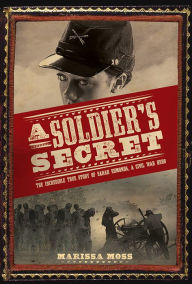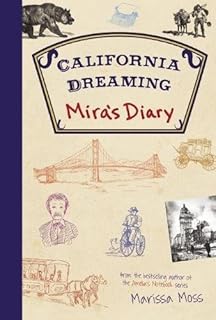Falkner,
Matt (2014) Gaijin: American Prisoner of War New York: Disney
Hyperion.

Opening
lines: Sunday, December 7. 1941. It’s Koji Miyamoto’s 13th
birthday. // “Koji – why don’t you turn on the radio while we do the
dishes.” “Sure thing, Ma,” / “How about
I wash and you dry.” “Okay.” / “Hi-Yo,
Silver!” “Swell, the Lone Ranger!”

This graphic novel follows the life
of 13-year-old Koji Kiyamoto. Koji lives
in San Francisco with his mom. His
Japanese father is overseas. When Pearl
Harbor is bombed, Koji starts being bullied at school, then the authorities
confiscate the radio, and then finally, Koji and his mom get a letter that he
is being taken to a relocation camp.
After Koji runs afoul of a gang of boys who ridicule him and call
him gaijin (Japanese for foreigner) because of his mixed-race ancestry and gets
in a fight, the camp commander assigns him to be an assistant to Mr. Asai, a
Japanese man who fixes things in the camp.
When Koji accompanies Mr. Asai to his house on a day pass, they find
that the couple renting Mr. Asai’s house have taken it over, broken into his
storage room, and stolen and sold his stuff.
Later, though, Koji’s affection for Mr. Asai is tested when the
gang peer-pressures him into throwing a dirt clod at Mr. Asai. And the bottom line of this graphic novel is
that it is as much about Koji growing up and grappling with divided loyalties
as it is about the way the United States handles (or mishandled) the treatment
of Japanese –American citizens. Koji is also worried that his mom is spending
time with the American guards at the camp and is being unfaithful to his
father.
In an afterward, Matt Faulkner tells the story of a great aunt of
his who fell in love with a Japanese man, married, moved to Japan, then, an
earthquake in Tokyo caused them to move
back to Boston. After the bombing of
Pearl Harbor, they got a letter saying that her husband and children would be
taken to an internment camp. Though
Faulkner’s aunt (who was Irish –American) was not required to be interred, she
chose to go to the camp with her family.
This became the basis for Faulkner’s graphic novel.
Generally, this is a good book.
The drawing is strong, though the caricature-like style that Faulkner
employs at times made it hard for me to fully invest myself in the main
character. Also, the lettering is
clearly typeset, which makes the voice of the novel seem stilted and
sterile. Some readers may take offences
at the repeated use of the term “Jap” to refer to Japanese American characters
in the book. Overall, though, the story
realizes important questions we still struggle with today, including, what it
means to be an American, including how we treat those who look different from
us, and what it is like to be an outsider. Faulkner’s book teases these ideas
out over a variety of narrative turns.
The ending seems a bit rushed, but is still satisfying.
This would be a good acquisition for a classroom library and might also work well as a supplemental book for classes studying the Japanese iInternment Camps in World War Two.



This would be a good acquisition for a classroom library and might also work well as a supplemental book for classes studying the Japanese iInternment Camps in World War Two.
Moss,
Marissa (2012) A Soldier’s Story: The Incredible True Story of Sarah Edmonds, a
Civil War Hero

Opening
lines: “Just a minute there,” the
recruiter stops me as I lean over to dip the pen in ink. “You can’t enlist.”
I freeze. Can he tell?
I’m wearing a shirt, vest, and trousers as usual. My curly hair cut short except for a lock
that insists on falling over my forehead.
I brush it away nervously and meet the man’s eyes. I’ve been passing for nearly three years now,
but every new encounter still brings with is the same fear. I take nothing for granted. The key thing, I remind myself is not to reveal
anything, to act as normal as possible.
“I beg your pardon,” I say as if I
haven’t heard him clearly. I keep my
voice calm and low, pushing down the panic that’s building up inside me.
“I know you love your country,” the
man says kindly. “but you need to grow up a bit before you join the army.” He looks at my peachy cheeks, free of any
sign of a whisker. “We aren’t taking
sixteen-year-olds.”
Eventually, though, Sarah Edmonds,
AKA “Frank Thompson” joins the Union Army. As she marches off the war we begin to slowly
learn about her early life with an abusive father in Canada. We find out what drove her from home and prompted
her to disguise herself as a boy. We find
out about how she kept herself alive by doing odd jobs and eventually becoming
a book salesman, and we find out why she wanted to enlist.
Frank is affable and funny and a
hard worker. As we follow Frank through
serving as a soldier, mail deliverer, spy, and nurse, we get to know the other
soldiers, experience some of the important battles of the civil war, learn
about daily life for soldiers, and most of all become more and more invested in
Frank’s life. At several points, she is
almost discovered to be a woman. She
also falls in love with her fellow soldiers more than once and must hide her
feelings. In this book readers will find
adventure, history, and some interesting ideas and themes to think about.
While teachers will want to know that
the book contains some mild and very occasional vulgar language, they should
also know that it is a gripping book that will engage readers deeply. It would probably work best for high school
students, but skilled and adventurous middle school readers might want to give
it a try as well. Though some boys
eschew books with female narrators, they might want to give this one a
try. The descriptions of battles and spy
missions are enough to hold the attention of action/adventure addicts. Moss
includes excellent supplemental materials including biographies of generals, a
civil war timeline, bibliographies, and an explanation of who the real Sarah
Edmonds was.
Excellent for your classroom library
or for use in conjunction with a unit on the American Civil War.
Bradley,
Kimberly Brubaker (2015) The War that
Saved my Life. New York: Dial

Opening
Lines: “Ada! Get back from that window!” Mam’s voice, shouting. Mam’s arm, grabbing mine. Yanking me so I toppled off my chair and fell
hard on the floor.
“I
was only saying hello to Stephen White.”
I knew better than to talk back, but sometimes my mouth was faster than
my brain. I’d become a fighter, that
summer.
Mam smacked me. Hard.
My head snapped back against the chair leg and for a moment I saw stars.
It is 1939 in London. Ada
is ten years old. Ada has a club
foot. Because her mother is ashamed of
this physical difference, she abuses Ada physically and emotionally. Ada is never to go outside and always to stay
away from windows. Ada’s younger brother
Jamie, who is 6, is allowed to leave the house and play with his friends in the
streets.
When World War Two breaks out, and London is threatened with
bombings, the government orders that children be evacuated to the country. Mam intends to send Jamie to the country, but
keep Ada in London, since Ada is an embarrassment. Instead, Ada and Jamie both escape and are
sent to the country. Once they arrive,
all the other children are claimed, but not them. Jamie and Ada are dirty, poorly dressed, and
lack manners. Eventually the woman
coordinating the resettlement in the town sends them to live with Miss Smith
who lives on the edge of town. Miss
Smith is not excited about taking them in.
It turns out that Susan Smith lived in the little cottage with her best
friend Becky, and since Becky has died, Miss Smith has been in a state of grief
and depression. At first, Ada and Jamie
take care of the cooking and cleaning, and Susan seldom leaves her bedroom. Eventually, though, she begins to take a hand
in the kid’s upbringing. Ada, who has never
known what it is like to walk without pain, learns the joy of riding a
horse. Miss Smith remembers what it is
like to care for another person and slowly they begin to build a new life as a
kind of family – but the war, bombing, Mam, and other conflicts threaten.
And like many great books, the summary of this book does not
convey what it is like to read it. This
book is delightful, and soon the reader is drawn into the little English town
and is rooting so hard for Ada and Susan that the book becomes all
encompassing. I would say it will have
you turning pages faster and faster to find out what is going to happen, except
the writing is so good that it will slow you down so you can enjoy it.
It would be a excellent book for a middle school or high school History
class to be able to personalize the war and help student to understand what it
was like for non-combatants at the time. It is also well-written enough that it
would be an excellent addition to a middle school or high school English/Language
Arts class. And it would make a splendid
read-aloud book.
It may be worth mentioning that there are very subtle yet clear
implications that Susan and Becker were lovers, however, if the teacher does
not focus on this, the majority of high school or middle school students will
fail to make the connection. Still,
teachers should be aware of this.
And what a splendid ending.
Look, you should buy this and read it yourself if you do nothing else.
Moss, Marissa (2016) Mira’s
Diary: California Dreaming. Berkeley: Creston.

Opening lines: “July
10. Usually I start a brand new journal
with a brand new postcard, a picture of where I’ll travel to next. But this time I’m starting with a drawing of
what’s right in front of me, because it’s pretty spectacular.
“Much better than
looking right next to me, at my oh-so-furious brother. We’re finally doing something fun, taking a
ride on the giant Ferris wheel in London and he looks ready to kill me.”
This is part of
an ongoing series in which Mira travels through time, trying to find her mother
(and defeat the mysterious watcher who is working against them.). In this one,
Mira must journey back to San Francisco just after the great earthquake. She gets a job as an entertainment reporter
and rubs shoulders with Mark Twain, finds her mother, another time traveler,
and the watcher. Along the way she is
continually orienting herself based on her knowledge of both modern and historical
San Francisco. Her knowledge of history
helps her out more than once. The book
does a nice job of showing that history happens in neighborhoods and cities
where people carry out their regular day-to-day lives. There is also a strong freedom-of-speech,
anti-censorship theme. There is also the beginning of a romance happening.
While this book
is perhaps not as gripping as Moss’s A
Soldier’s Story, it seems like a good way to engage late elementary or middle
school students in beginning to think aobut their world from a historical
perspective. I have not read the other books in the series, but suspect they
also would serve this purpose well.
No comments:
Post a Comment